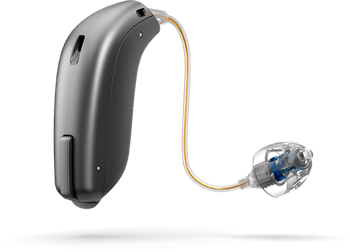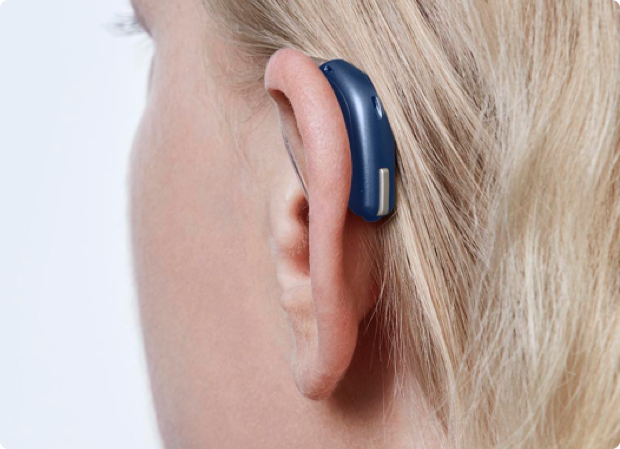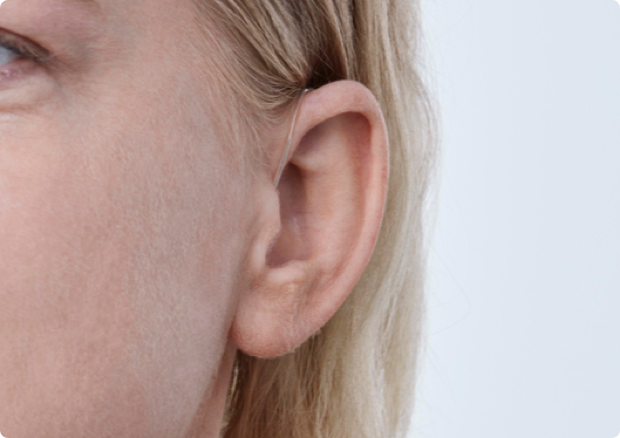Receiver-in-Canal Behind-the-Ear: RIC BTE
Solid performing, durable hearing aids for people with mild to severe hearing loss.

DEVICE APPEARANCE
How the RIC Hearing Aid Looks and Feels
A further development from the BTE is the receiver-in-canal hearing aid (RIC). It looks the same as the thin tube BTE, except that a wire passes through the thin tube instead of sound. The key difference is that the speaker is housed inside the dome which fits snugly into the ear canal. Different sizes of domes can accommodate different sizes of ear canals and hearing loss.
For those severe-to-profound hearing losses, a high-power RIC BTE is required with a custom ear mold instead of a dome. Consideration of ear canal size, shape, hearing loss and needs are taken into consideration during the consultation to determine the best acoustical fit of the hearing aid.


AUDIO NOTES
RIC Hearing Aids Feature a Natural Sound Profile
A wire connects the amplifier housed in the main body of the hearing aid to the speaker that is housed inside the dome, which sits inside the ear canal. In hearing aid language, the word “receiver” means “speaker.” That’s why this style is called RIC (receiver-in-canal). Since the speaker is closer to the hearing aid wearer’s eardrum, the RIC BTE hearing aid offers superior sound to the thin tube BTE. The sound is also perceived as more natural and the distance from speaker to microphone helps negate issues with feedback.
Try Our Online
Hearing Test
Concerned about your hearing? Try our free no
obligation hearing screening test. This interactive test will
help you determine whether a professional consultation
would benefit you.

CUTTING-EDGE HEARING AIDS
Which Hearing Device Is Right for You?
BTE: Behind the Ear
Learn More
CIC: Completely in
Canal
Learn More
Extended Wear
Learn More
IIC: Invisible in Canal
Learn More
Mini-Canal
Learn More
ITC: In the Canal
Learn More
RIC: Receiver in Canal
Learn More
PROS AND CONS
Determining Whether RIC Hearing Aids Are Right for You
The RIC hearing aids is by far the most popular hearing aid style sold today with its unique comfort fit and aesthetically obscure positioning. It can accommodate many options and power levels for various degrees of hearing loss.
The receiver is especially subjected to natural moisture in the ear canal, but a regular care and maintenance routine will help reduce the need for repairs. It’s important to discuss all the options with your hearing health practitioner to ensure you find the hearing aid that will work best for your unique preferences.


HEARING AID TECHNOLOGY
Options to Consider When Selecting a Hearing Aid
The RIC hearing aids can accommodate larger, size 312 and size 13 batteries and are available with rechargeable solutions. Modern Bluetooth connectivity to other devices including smartphones, TVs, computers, music players, and remote microphone accessories expand the options of this model. Digital hearing aids have advanced processors that provide better sound quality and speech understanding in background noise.
ANSWERS ABOUT HEARING AIDS AND MORE
Frequently Asked Questions
While these two types of hearing aid look very similar, how they function is quite different. The main difference is the location of the receiver chip which is the component that outputs sound from the hearing instrument. In a behind the ear hearing device, the receiver chip is located in the main body of the device that sits behind the ear. The receive sends sound through a tube to the dome that sits in the ear canal. In a receiver in canal hearing aid, the receiver chip is located in the dome in the ear canal, and the main body of the device is connected to the dome by a small wire instead of a tube.
Because there is an electronic component inside the dome of a receiver in canal hearing aid, the domes need to be replaced regularly. It is recommended to replace the dome at least once a month, or as directed by our clinic staff.
There are two main advantages to using a receiver in canal hearing aid instead of a behind the ear hearing aid.
First, In a receiver in canal hearing aid, the receiver and microphone components are much further apart compared to a BTE device. This results in the RIC device experiencing less feedback than a behind the ear hearing aid.
Second, since the receiver, one of the larger primary components in the main body of a behind the ear hearing aid, is found in the dome of a RIC device, the size of an RIC device is usually smaller, while usually still being able to use the same size of battery. This allows wearers to get the battery power of a BTE device in a sleeker and more discreet model of hearing aid.
Yes you can! Because a receiver in canal hearing aid has a very similar design to a BTE device, many RIC hearing aids come with manual volume controls on the main body that sits behind your ear. There are also some models that allow volume control through a remote or a smartphone app.
A receiver in canal hearing aid is a great option for people with moderate to severe hearing loss since they are among the most powerful types of hearing aid on the market. Anyone who wants a hearing aid with advanced functionality such as directional microphones, Bluetooth connectivity, and advanced sound processing would benefit greatly from this type of device which has many models and options available. People who need a powerful hearing aid but want something that is discreet as well should also consider this style of hearing device.
We would love to
hear from you!
assessment or hearing devices the professionals at NexGen Hearing
have the answers. Send us your contact information and we’ll be in
touch. Remember, there’s never any obligation and you’ll never be
pressured to make a purchase! We’re here to help!
Head Office
201 – 4500 West Saanich Rd.
Victoria, British Columbia
Canada, V8Z 3G2